Garden & Plants / Plants that grow well at Earlscliffe / Picture Gallery / 4 year pictorial study of plants / Plants in 2002
Previous / Next: Plants in 2001 / Plants in 2003
Previous 'Plants of the month' 2002
Plant of the month for December 2002
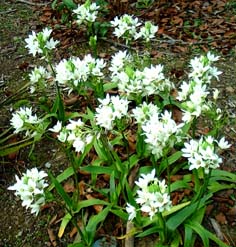 Ornithogalum
thyrsoides (Chincherinchee) from South Africa has surprised many visitors
with its long lasting flowers, still completely unblemished in the last days of
December. The bulbs were not received until late May 2002 and had already
sprouted in the net. They were planted carefully and have given a good splash of
colour from September right up to the New Year. Ornithogalum thrysoides
is noted for its long lasting flowers and the mild autumn/early winter period
this year has suited it well. It will be interesting to see if a similar winter
display can be obtained by late planting in future years.
Ornithogalum
thyrsoides (Chincherinchee) from South Africa has surprised many visitors
with its long lasting flowers, still completely unblemished in the last days of
December. The bulbs were not received until late May 2002 and had already
sprouted in the net. They were planted carefully and have given a good splash of
colour from September right up to the New Year. Ornithogalum thrysoides
is noted for its long lasting flowers and the mild autumn/early winter period
this year has suited it well. It will be interesting to see if a similar winter
display can be obtained by late planting in future years.
Plant of the month for November 2002
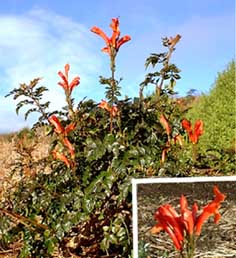 A
young plant of Tecomaria capensis (Cape Honeysuckle), from southern
Africa, photographed on an exposed hillside in late November. This is a popular
flowering shrub in warm countries but is not often seen in Irish gardens. This
plant has flowered well in October and November despite exceptionally high
rainfall in both months.
A
young plant of Tecomaria capensis (Cape Honeysuckle), from southern
Africa, photographed on an exposed hillside in late November. This is a popular
flowering shrub in warm countries but is not often seen in Irish gardens. This
plant has flowered well in October and November despite exceptionally high
rainfall in both months.
Plant of the month for October 2002
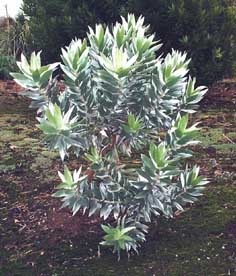 Leucadendron
argenteum (Silver tree) from Table Mountain, South Africa is one of the most
beautiful of all trees in foliage. The closely adpressed hairs give the
impression that the leaves are covered with silver fur and the plant gives a
welcome splash of light on dull autumn days. The Silver Tree is short lived as
it is susceptible both to low temperatures and wet conditions. So far this
specimen has survived the cold 2000/01 winter as a young seedling without
protection and also the milder 2001/02 winter. It has also stood up well to the
current exceptionally wet October.
Leucadendron
argenteum (Silver tree) from Table Mountain, South Africa is one of the most
beautiful of all trees in foliage. The closely adpressed hairs give the
impression that the leaves are covered with silver fur and the plant gives a
welcome splash of light on dull autumn days. The Silver Tree is short lived as
it is susceptible both to low temperatures and wet conditions. So far this
specimen has survived the cold 2000/01 winter as a young seedling without
protection and also the milder 2001/02 winter. It has also stood up well to the
current exceptionally wet October.
Postscript. Sadly, all of these plants died in the winter of 2009/10.
Plant of the month for September, 2002
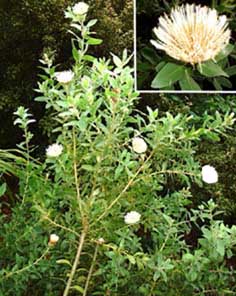 Protea
lacticolor is the hardiest Protea tested so far at Earlscliffe, surviving
most winters in an undamaged condition. Planted in 1996, it is now a small tree
over 2.5 metres tall and tolerated -7°C in December 2000. In addition to cream
coloured flowers the plant has attractive, soft blue green foliage. It could be
more widely planted in mild gardens in Ireland.
Protea
lacticolor is the hardiest Protea tested so far at Earlscliffe, surviving
most winters in an undamaged condition. Planted in 1996, it is now a small tree
over 2.5 metres tall and tolerated -7°C in December 2000. In addition to cream
coloured flowers the plant has attractive, soft blue green foliage. It could be
more widely planted in mild gardens in Ireland.
Postscript. Sadly, this plant also died in the winter of 2009/10.
Plant of the month for August, 2002
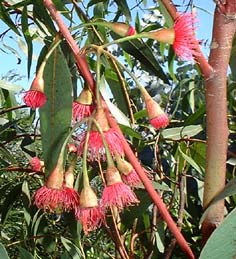 The
Red Flowered Yellow Gum (Eucalyptus leucoxylon var. macrocarpa
flowered for the first time at Earlscliffe in August, 2002. This plant was
raised from seed sown in 1996 and has proved to be much hardier than the Red
Flowering Gum Eucalyptus ficifolia, large numbers of which, sown at the
same time as E. leucoxylon, perished in the cold 2000/01 winter. Despite
various attempts to enrich the garden with red eucalyptus flowers, including
planting out large numbers of E. ficifolia raised from seed collected at
different locations in Australia in 1996 and crossing E.pulverulenta with
E. caesia, the plant in the picture is the first eucalypt to produce red
flowers at Earlscliffe since 1976. In the autumn of that year E. ficifolia
flowered before being killed by low temperature during the winter. As
E.leucoxylon survived -7º C in December 2000, this species may yet prove to
be a useful ornamental for mild areas in Ireland.
The
Red Flowered Yellow Gum (Eucalyptus leucoxylon var. macrocarpa
flowered for the first time at Earlscliffe in August, 2002. This plant was
raised from seed sown in 1996 and has proved to be much hardier than the Red
Flowering Gum Eucalyptus ficifolia, large numbers of which, sown at the
same time as E. leucoxylon, perished in the cold 2000/01 winter. Despite
various attempts to enrich the garden with red eucalyptus flowers, including
planting out large numbers of E. ficifolia raised from seed collected at
different locations in Australia in 1996 and crossing E.pulverulenta with
E. caesia, the plant in the picture is the first eucalypt to produce red
flowers at Earlscliffe since 1976. In the autumn of that year E. ficifolia
flowered before being killed by low temperature during the winter. As
E.leucoxylon survived -7º C in December 2000, this species may yet prove to
be a useful ornamental for mild areas in Ireland.
Postscript. It was thought that this tree died in the winter of 2009/10. However, it has started to grow again at the base of the tree.
Plant of the month for July, 2002
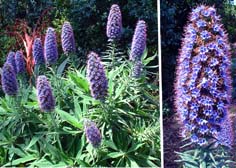 Echium candicans, the Pride of Madeira, makes a useful focal point in the
garden in early July. This plant is the sole surivivor of a batch of seedlings I
raised in spring 2000 and planted out later that year. The 2000/01 winter was
the most severe for many years and so a question now arises about the hardiness
of this particular plant. Is its survival a freak accident or is it hardier than
the general population of E. candicans?.
Echium candicans, the Pride of Madeira, makes a useful focal point in the
garden in early July. This plant is the sole surivivor of a batch of seedlings I
raised in spring 2000 and planted out later that year. The 2000/01 winter was
the most severe for many years and so a question now arises about the hardiness
of this particular plant. Is its survival a freak accident or is it hardier than
the general population of E. candicans?.
As this plant is a biennial, it will die this winter and so if it produces any seeds I will certainly collect them.Will the seed be viable?Will the progeny be pure E. candicans seedlings or a hybrid with E. pininana, which is flowering in the vicinity?If the seed is pure will the resulting seedlings be hardier than the general run of E. candicans as the parent plant has already survived - 7ºC, whereas the rest of the batch succumbed? Plenty of questions to be answered and plenty of opportunities to try to enrich Irish gardens with hardier plants.
Postscript. It was thought that all of these plants had died in the winter of 2009/10. However, a patch of them survived and flowered in the summer of 2010.
Plant of the month for June, 2002
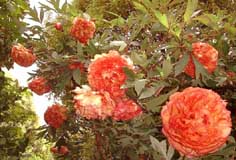 This
tree paeonia is P. x lemoinei (P. lutea x P. suffruticosa)
variety 'Souvenir de Maxime Cornu'. The plant is at least 50 years old but still
blooms prolifically in early June. The large, golden yellow, reddish orange
flowers are about 20 cm in diameter and are slightly fragrant. They provide a
good contrast to those of rhododendron which tend to dominate the garden at this
time of the year.
This
tree paeonia is P. x lemoinei (P. lutea x P. suffruticosa)
variety 'Souvenir de Maxime Cornu'. The plant is at least 50 years old but still
blooms prolifically in early June. The large, golden yellow, reddish orange
flowers are about 20 cm in diameter and are slightly fragrant. They provide a
good contrast to those of rhododendron which tend to dominate the garden at this
time of the year.
Plant of the month for May 2002
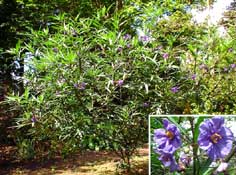 A
thirteen month old plant of Solanum laciniatum - the Kangaroo Apple from
Australia or the Poroporo from New Zealand. Although hardy in most years, all
plants of S. laciniatum at Earlscliffe were killed by the cold 2000/01
winter. The plant in the photograph is a self sown seedling which germinated in
April 2001 and reached a height of over 2 metres and a spread of over 3 metres
by May 2002. The berries are a bright orange colour and the seed germinates
readily so that S. laciniatum can be a weed in places. However it is very
shallow rooting and can be easily eliminated.
A
thirteen month old plant of Solanum laciniatum - the Kangaroo Apple from
Australia or the Poroporo from New Zealand. Although hardy in most years, all
plants of S. laciniatum at Earlscliffe were killed by the cold 2000/01
winter. The plant in the photograph is a self sown seedling which germinated in
April 2001 and reached a height of over 2 metres and a spread of over 3 metres
by May 2002. The berries are a bright orange colour and the seed germinates
readily so that S. laciniatum can be a weed in places. However it is very
shallow rooting and can be easily eliminated.
Plant of the month for April 2002
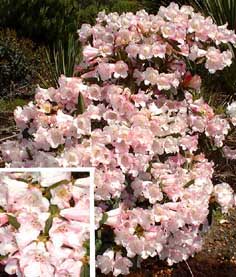 Rhododendron
'Countess of Haddington' a well scented hybrid that flowers reliably every
year.
Rhododendron
'Countess of Haddington' a well scented hybrid that flowers reliably every
year.
Plant of the month for March 2002
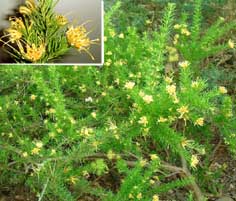 Grevillea
juniperina f. sulphurea is another Australian plant that is
completely hardy at Earlscliffe, surviving the harsh 2000/01 winter completely
unscathed. A native of New South Wales, it is not particularly showy but it
attractive with its soft, downy, rosemary-like shoots and small, pale yellow
flowers crowded in terminal clusters.
Grevillea
juniperina f. sulphurea is another Australian plant that is
completely hardy at Earlscliffe, surviving the harsh 2000/01 winter completely
unscathed. A native of New South Wales, it is not particularly showy but it
attractive with its soft, downy, rosemary-like shoots and small, pale yellow
flowers crowded in terminal clusters.
Plant of the month for February 2002
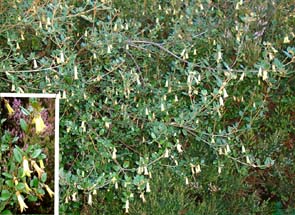 Correa
backhousiana, a beautiful shrub from Tasmania, is about 3 metres high at
Earlscliffe and usually displays at least a few flowers every month of the year.
The petals are light yellow in colour and are united into a funnel shaped
corolla about 3 cm long. C. backhousiana is perfectly hardy here and has
never shown any low temperature or wind damage.
Correa
backhousiana, a beautiful shrub from Tasmania, is about 3 metres high at
Earlscliffe and usually displays at least a few flowers every month of the year.
The petals are light yellow in colour and are united into a funnel shaped
corolla about 3 cm long. C. backhousiana is perfectly hardy here and has
never shown any low temperature or wind damage.
Plant of the month for January 2002
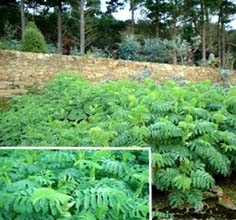 After
an unusually mild winter, to the end of January 2002 at least, Melianthus
major is looking particularly well, with no sign of wind or frost damage
even at the end of the month. A large bank of this South African sub-shrub
creates a subtropical atmosphere with its long pinnate, evergreen, slightly
glaucous leaves. This plant is well adapted to the microclimate at Earlscliffe
although self sown seedlings of this aggressive plant can occasionally be a
nuisance among slow growing trees and shrubs.
After
an unusually mild winter, to the end of January 2002 at least, Melianthus
major is looking particularly well, with no sign of wind or frost damage
even at the end of the month. A large bank of this South African sub-shrub
creates a subtropical atmosphere with its long pinnate, evergreen, slightly
glaucous leaves. This plant is well adapted to the microclimate at Earlscliffe
although self sown seedlings of this aggressive plant can occasionally be a
nuisance among slow growing trees and shrubs.
Plant Collections
For more details of the plants that grow at Earlscliffe, see the following pages
Plants that grow well at Earlscliffe
4 year pictorial study of plants at Earlscliffe (2000 to 2003)
